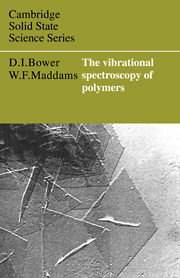Book contents
- Frontmatter
- Contents
- Preface
- 1 Introduction
- 2 Symmetry and normal modes of vibration
- 3 The vibrational modes of polymers
- 4 Infrared and Raman spectra
- 5 The characterization of polymers
- 6 The microstructure of polymers
- References for chapters 5 and 6
- A note on the use of the indexes
- Index of spectra illustrated
- Index of point groups
- Index of group modes
- Index of polymers
- Main index
3 - The vibrational modes of polymers
Published online by Cambridge University Press: 05 May 2010
- Frontmatter
- Contents
- Preface
- 1 Introduction
- 2 Symmetry and normal modes of vibration
- 3 The vibrational modes of polymers
- 4 Infrared and Raman spectra
- 5 The characterization of polymers
- 6 The microstructure of polymers
- References for chapters 5 and 6
- A note on the use of the indexes
- Index of spectra illustrated
- Index of point groups
- Index of group modes
- Index of polymers
- Main index
Summary
The vibrations of regular polymer chains
Introduction
It has been pointed out already, in section 1.3, that the spectra of polymers are a great deal simpler than might at first be expected, because of the repetitive nature of the structure of the polymer chain. In this section we wish to make the arguments presented earlier more precise by first considering the vibrations of a single perfectly regular polymer chain.
We define a perfectly regular chain to be one with which a straight line can be associated in such a way that all translations of the chain parallel to this line by integral multiples of some basic distance are symmetry operations, i.e. they bring the chain into exact coincidence with itself when the indistinguishability of all atoms of the same type is taken into account. Such a polymer chain cannot exist in reality, since it would have to be of infinite length, but in polymer crystals there are considerable lengths of chain for which such translations may be considered to be symmetry operations to a first approximation. Even in the non-crystalline regions of solid polymers there can sometimes be appreciable lengths of such straight chains. Since the interactions between the atoms in the same chain are often, but not always, considerably greater than those between the atoms in adjacent chains, the isolated perfectly regular polymer chain is a good starting point for the discussion of the normal vibrations and vibrational spectra of polymers.
- Type
- Chapter
- Information
- The Vibrational Spectroscopy of Polymers , pp. 80 - 106Publisher: Cambridge University PressPrint publication year: 1989
- 1
- Cited by



